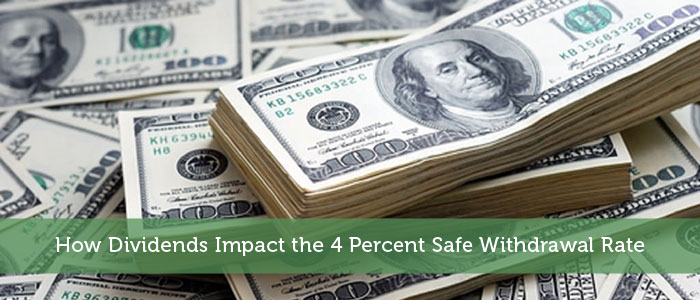When I first started looking at planning for retirement and following personal finance blogs, I came upon the concepts of early retirement and the 4 percent “safe withdrawal rate.” I wondered what this all meant. This safe withdrawal rate, also known as the SWR, comes from the Trinity Study.
This study back-tested how much a person could take out from his nest egg and not run out of money before 30 years elapsed. Of course, those who retire at the “normal” age of 65 will probably die before they hit 30 years of retirement. Therefore, these folks would theoretically not run out of money before they die.
The Trinity Study argued that a withdrawal rate of 4 percent would allow a person to keep up with inflation and never run out of money. The success rate in this instance was more than 95 percent, and only those who retired in 1965 and 1966 would have been unable to sustain their living standards at a 4 percent withdrawal rate. The portfolio tested held the S&P 500 and quality corporate bonds.
Problems With The Safe Withdrawal Rate
Most people who cite the Trinity Study seem to advocate just liquidating 4 percent of their shares in whatever index funds they might happen to have. Whether you’re looking to replace your estimated annual spending or 80 percent of your pre-retirement income, your portfolio would have to be pretty big to live on 4 percent.
If a person needs $40,000 to live, she’d need a portfolio of $1 million based upon the 4 percent SWR. If she happens to retire in a really bad year like 2008/2009, her portfolio might drop to $500,000 or $600,000. A $40,000 withdrawal would then take out between 6 and 8 percent of the total portfolio, which would make it less likely that our hypothetical retiree would make it to the end with money left over.
This means that the SWR might change from $40,000 to more like $20-$25,000. In this instance, the retiree would have to severely cut back on her standard of living. While this is not ideal, the news is not as bad as it might seem.
Recommended Dividend Investing Posts:
How Dividends Affect The Safe Withdrawal Rate
Many investors do not really want to invest for dividends. Warren Buffett is famous for refusing to pay dividends, choosing instead to use all profits from Berkshire Hathaway (BRK.A, BRK.B) to continue building the business (even if he doesn’t mind getting them from companies he owns). Regardless, the S&P 500 has a current dividend yield of right around 2 percent. This means that a person who needed $40,000 from a $1 million portfolio would not need to withdraw $40,000.
The dividends from a S&P 500 index fund like Vanguard’s VOO would come in at close to $20,000 for a year. With the exception of the horrible year of 2008, the dividend yield of the S&P has been between 1.6 and 2.2 percent at the end of every other year since the dot-com crash.
When an investor can expect about $20,000 from dividends, and he needs $40,000 to live, he’ll only have to withdraw $20,000 from the $1 million portfolio referenced above. This is, in effect, a 2 percent withdrawal rate, which means that the likelihood of success would be even higher.
If the investor chose to invest in the Vanguard Total Stock Market ETF (VTI), the dividend yield is still 1.9 percent (as of April 13, 2017) even when including many companies that don’t pay dividends. This would pay out $19,000 on a $1 million portfolio, which would lead to an investor needing a withdrawal of $21,000, or 2.1 percent, to reach $40,000 for living expenses.
Fritz Gilbert from The Retirement Manifesto discusses this possibility when discussing his retirement bucket strategy “Alternatively, you can divert your dividend and interest earnings from Buckets Two and Three as a steady stream of cash into Bucket One. I think of the “dividend diversion” as a “Drip Refill” strategy, and plan on using that in my retirement.”
Conclusion
It seems as though most people who write on the safe withdrawal rate for early, or even plain old regular, retirement ignore the benefit that dividends can provide. In some instances, the dividends could help people to retire even earlier than they might think. Of course, it is possible that dividends for the S&P could get cut like they were in the Great Recession; however, they are still a positive cash flow that could keep the overall necessity for withdrawals quite a bit lower than the 4 percent SWR advocated by many personal finance gurus.
This would indicate that retirees could theoretically have a higher standard of living than they would have expected had they intended to use the 4 percent withdrawal rate only. If they choose to stick with the lower number even after receiving dividends, they’re likely to have a much bigger nest egg than they might have expected. Of course, there could be worse problems to have than a higher standard of living or a bigger estate to leave to one’s heirs.
This author has no positions in any stock mentioned and does not plan to open any positions in any stocks mentioned for at least 72 hours after publication of this article.
Author Bio:When Chris Price is not teaching history to college students, he’s active in reading up on all things related to history, personal finance and travel hacking.






I’m seeing elsewhere that the 4% SWR does include dividends. If you are paid $20,000 in dividends off a $1 million portfolio and withdraw that 20k, then that supposedly counts as part of the 4% withdrawal (2% in this case).
Maybe I missed something in your article, but it seems like you’re saying if I withdraw 20k in dividends (from 1 million) and another 20k from my portfolio, then that’s actually a 2% withdrawal (the other 2% being a “free lunch” from the dividends).
Could you clarify? Thank you.